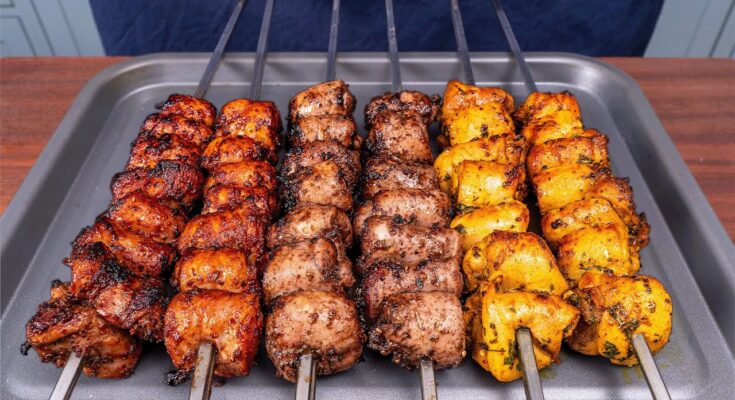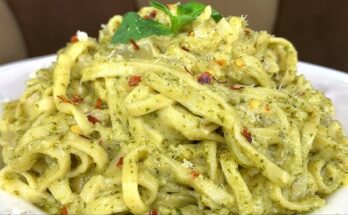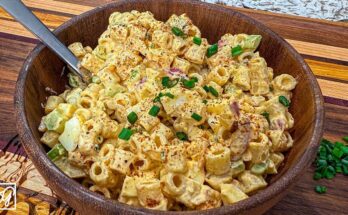Shish Kabob Recipe: Shish kabobs are more than just grilled meat on a stick—they’re a globally beloved dish that combines sizzling protein, colorful vegetables, and mouthwatering marinades. The term “shish kabob” originates from the Turkish words “şiş,” meaning skewer, and “kebap,” meaning roasted meat. Traditionally, they consist of marinated chunks of meat (often lamb, beef, or chicken) threaded onto skewers along with vegetables like bell peppers, onions, mushrooms, and zucchini.
Shish kabobs are versatile and can be customized endlessly based on your preferences. Whether you’re a meat lover or a vegetarian, there’s a version of kabobs that will suit your taste. Perfect for backyard cookouts, weeknight dinners, or even meal prep, these skewers are packed with flavor, easy to prepare, and always a hit at the table.
History and Origin
The history of shish kabobs dates back centuries to the Middle East. It’s believed that medieval Turkish soldiers grilled meat skewered on their swords over open fires. The idea spread across continents, and now almost every culture has a version of skewered, grilled meat—from Japanese yakitori to Greek souvlaki.
As the kabob made its way into Western kitchens, it evolved. Americans often include more vegetables and a wider variety of meats and spices. This evolution has made shish kabobs a popular staple at barbecues and summer gatherings, symbolizing both cultural fusion and culinary creativity.
Ingredients Needed
Choosing the Right Meat
The star of any shish kabob is undoubtedly the meat. You’ll want to select a cut that’s tender, flavorful, and suited for grilling. Here are the best choices:
- Beef: Sirloin, ribeye, or tenderloin are great options because they cook quickly and stay juicy.
- Chicken: Thighs are preferred over breasts due to their higher fat content, which helps them stay moist.
- Lamb: Boneless leg of lamb or shoulder is commonly used in traditional Middle Eastern kabobs.
- Seafood: Shrimp or scallops can be used, but they require different marinating and grilling times.
Make sure to cut the meat into uniform cubes, roughly 1 to 1.5 inches thick. This ensures even cooking and prevents dry spots.
Vegetables That Work Best
Vegetables aren’t just filler—they add color, texture, and sweetness to your kabobs. Here are some popular choices:
- Bell peppers (red, yellow, green)
- Red onions
- Cherry tomatoes
- Mushrooms
- Zucchini or summer squash
- Pineapple (for a sweet touch)
The key is to choose firm vegetables that can withstand high heat without falling apart. Cut them to match the size of the meat so everything cooks evenly.
Marinade Ingredients
A good marinade is what transforms your kabobs from average to unforgettable. A basic marinade consists of:
- Acid: Lemon juice, vinegar, or yogurt to tenderize the meat
- Oil: Olive oil helps distribute flavors and keeps things moist
- Flavorings: Garlic, onions, mustard, or herbs like oregano and thyme
- Spices: Paprika, cumin, chili flakes, salt, and pepper
Let the meat marinate for at least 1 hour, but for best results, leave it overnight in the fridge. Vegetables should be marinated separately to prevent them from becoming too mushy.
Tools You’ll Need
Skewers – Wooden or Metal?
Skewers are essential. You have two main choices:
- Wooden Skewers: Inexpensive and disposable, but they need to be soaked in water for at least 30 minutes before use to prevent burning.
- Metal Skewers: Reusable and heat-conductive, which helps meat cook more evenly. Look for flat, wide skewers to prevent food from spinning.
Each has its pros and cons. Wooden is great for parties or one-time use, while metal is more durable and eco-friendly.
Grill Type – Charcoal vs Gas
The grill you use affects the flavor of your kabobs:
- Charcoal Grill: Gives a smoky, rich flavor that’s hard to beat. It’s perfect for those who want authentic grill marks and a deep aroma.
- Gas Grill: More convenient and easier to control. Ideal for quick meals and consistent heat.
No matter what grill you use, preheating is crucial. A hot grill sears the meat, locking in juices and creating that irresistible caramelized crust.
Preparation Process
Cutting and Prepping Meat and Veggies
This step is all about consistency. Cut your meat and veggies into equal-sized chunks to ensure even cooking. Don’t go too small, or they might dry out or fall apart on the grill.
Keep raw meat separate from vegetables during prep. Use separate cutting boards to avoid cross-contamination.
Once everything is cut, place the meat in the marinade. Let it soak up all those bold flavors for at least an hour. While that’s happening, prepare your vegetables and, if using wooden skewers, start soaking them in water.
Marinating the Ingredients
Marinating isn’t just for flavor—it helps tenderize tougher cuts of meat. Use a zip-lock bag or a large bowl with a cover to marinate the meat. Turn occasionally to ensure every piece gets coated.
Avoid over-marinating. Too much acid can break down the meat’s fibers too much, making it mushy.
As for vegetables, toss them with a little oil and seasoning just before grilling. If they sit in marinade too long, they’ll lose their crunch and become soggy.
Skewering Tips for Even Cooking
Time to assemble! Alternate meat and vegetables on your skewers, but don’t pack them too tightly. Leaving a bit of space ensures even heat distribution and better caramelization.
Try grouping similar cooking time items together. For example, you might want to make some skewers just with meat and others with faster-cooking vegetables like tomatoes or mushrooms.
Now that your skewers are ready, it’s time to hit the grill!
Grilling the Kabobs
Cooking Temperature and Time
Now we’re getting to the fun part—grilling those juicy, flavor-packed skewers. The first rule of thumb? Make sure your grill is hot. You want a medium-high heat, around 375°F to 450°F. This high temp helps sear the meat quickly, locking in all the juices and giving your kabobs that irresistible char.
Here’s a rough guide for grilling times depending on the meat:
- Beef: 10–12 minutes, turning every 2–3 minutes
- Chicken: 12–15 minutes, ensure internal temp hits 165°F
- Lamb: 10–12 minutes for medium
- Shrimp or Fish: 5–7 minutes total
Vegetables usually take 8–10 minutes. That’s why separating them on different skewers makes sense—you can pull them off earlier without overcooking your protein.
Be mindful of flare-ups. Fat dripping onto flames can cause the fire to spike and burn your food. If that happens, move the kabobs to a cooler zone of the grill until the flames settle.
Turning and Basting for Flavor
Don’t just throw kabobs on the grill and forget about them—turning is key. Rotate each skewer every 2 to 3 minutes. This helps achieve an even cook on all sides and that beautiful golden-brown finish.
Want to take the flavor up a notch? Baste with reserved marinade or a butter-herb mix while grilling. Just be careful: never use the marinade that raw meat sat in. If you plan to baste, set some aside before marinating.
Another pro tip—finish your kabobs with a sprinkle of flaky sea salt or a squeeze of lemon juice right off the grill. It’ll brighten the flavors and give that gourmet touch.
Serving Your Shish Kabobs
Presentation Tips
Once your kabobs are off the grill, let them rest for a few minutes. This allows juices to redistribute, keeping the meat tender. Serve them directly on the skewers for a rustic look or slide everything off into a dish for easier eating.
Add a garnish—fresh herbs like parsley, cilantro, or mint really pop against the smoky colors. A drizzle of tzatziki, chimichurri, or garlic sauce on the side can elevate the whole plate.
Perfect Side Dishes
Kabobs are a meal on their own, but the right sides can turn dinner into a feast. Here are some top choices:
- Rice pilaf or couscous – Soaks up juices beautifully
- Grilled pita or naan – For scooping up everything on the plate
- Fresh Greek salad – Balances out the char with acidity
- Roasted potatoes or corn on the cob – Hearty and satisfying
Don’t forget a cool drink—a crisp white wine, sangria, or even mint lemonade pairs perfectly.
Storing and Reheating Leftovers
How to Store Kabobs Properly
Got leftovers? Lucky you. Proper storage ensures your kabobs stay fresh and safe to eat. First, remove the meat and veggies from the skewers to make storage easier. Place everything in an airtight container and refrigerate within two hours of cooking.
Kabobs will last in the fridge for up to 4 days. If you don’t think you’ll eat them in that time, freeze them. Separate pieces with parchment paper to prevent sticking and store in a freezer-safe container or zip-lock bag. They’ll keep for about 2 to 3 months.
When freezing, label the container with the date and contents. It’s a small step, but it makes life easier down the line when you’re digging through the freezer for a quick meal.
Best Reheating Methods
To reheat, skip the microwave if you can—it tends to make kabobs rubbery and unevenly heated. Instead, use:
- Oven: Preheat to 350°F, wrap kabobs in foil, and bake for 10–15 minutes
- Skillet: Reheat over medium heat with a splash of water or broth to prevent drying out
- Air fryer: A great way to restore crispiness, cook at 350°F for 5–7 minutes
If you’re in a hurry and use the microwave, cover the food with a damp paper towel and heat in 30-second intervals to avoid overcooking.
Common Mistakes to Avoid
Overpacking Skewers
One of the biggest shish kabob sins is cramming too much onto a single skewer. Overpacked skewers don’t cook evenly and can cause some ingredients to burn while others are undercooked. Give each piece a little breathing room.
Skipping the Soak for Wooden Skewers
It might seem minor, but forgetting to soak your wooden skewers can turn your kabob party into a mini bonfire. Always soak them in water for at least 30 minutes before grilling to prevent burning.
Uneven Cuts
Cut everything the same size. Uniform pieces mean even cooking. If your beef chunks are twice the size of your bell peppers, guess what? Something’s going to end up raw or burnt.
Creative Variations to Try
Vegetarian and Vegan Options
You don’t need meat to make killer kabobs. Try these combos:
- Tofu + Zucchini + Bell Peppers + Mushrooms
- Halloumi Cheese + Cherry Tomatoes + Olives
- Tempeh + Pineapple + Red Onion
Marinate tofu or tempeh in soy sauce, garlic, and maple syrup for a delicious plant-based version.
International Flavors
Switch up your marinade and ingredients to travel the globe from your backyard:
- Greek: Oregano, lemon, olive oil, and garlic
- Indian: Yogurt, curry powder, and cumin
- Korean: Soy sauce, sesame oil, brown sugar, and gochujang
- Mexican: Lime juice, chili powder, and cilantro
Changing the herbs, spices, and sauces can give your kabobs a fresh twist every time.
FAQs about Shish Kabob Recipe
1. Can I make shish kabobs in the oven?
Yes! Just preheat your oven to 400°F and bake kabobs on a foil-lined tray for 20–25 minutes, turning halfway through.
2. What’s the best meat for tender kabobs?
Beef sirloin, chicken thighs, and lamb shoulder are great choices—they stay juicy and grill beautifully.
3. How long should I marinate kabobs?
At least 1 hour, but 6–12 hours gives the best flavor. Don’t go over 24 hours, or the acid might break down the meat too much.
4. Should I cook kabobs with the lid open or closed on the grill?
Keep the lid closed to maintain consistent heat and faster cooking, especially for thicker meats.
5. Can I prep kabobs ahead of time?
Absolutely! Assemble them a day ahead and store covered in the fridge. Just grill when ready to serve.
Conclusion
Shish kabobs are more than a meal—they’re an experience. From the vibrant colors of the veggies to the sizzling sound of meat hitting the grill, they capture everything we love about cooking: simplicity, flavor, and a bit of flair. Whether you stick with the traditional Middle Eastern approach or explore creative new takes, kabobs are a crowd-pleaser that never disappoints.
Next time you’re firing up the grill, remember: great kabobs come from quality ingredients, a flavorful marinade, and a little bit of love. Try different combos, don’t be afraid to get messy, and most importantly—enjoy every bite!



